After seeing Australia, the Netherlands, and England scrape victories, and Canada and France held to goalless draws during the first few days of the Women’s World Cup, it would be a surprise if another of the pre-tournament favourites, Germany, did not go into their opening game against debutants Morocco, taking place at the Melbourne Rectangular Stadium, with some trepidation.
However, as it turned out, any who had doubts about their capabilities needn’t have worried, with Martina Voss-Tecklenburg’s Euro 2022 runners-up securing a convincing 6-0 win and laying down the gauntlet for the other 31 teams as they outlined their title credentials. It wasn’t a completely one-sided affair, with Morocco providing a few tests early on, but there was no doubt that the final scoreline was a good reflection of how Germany grew into the game.
Helping them to be so dominant was a great deal of pre-tournament planning and a well-thought-out game plan, and this tactical analysis will look at their tactics in closer detail to see why they managed to control proceedings and how they managed to restrict Morocco from themselves settling and playing their game.
Lineups
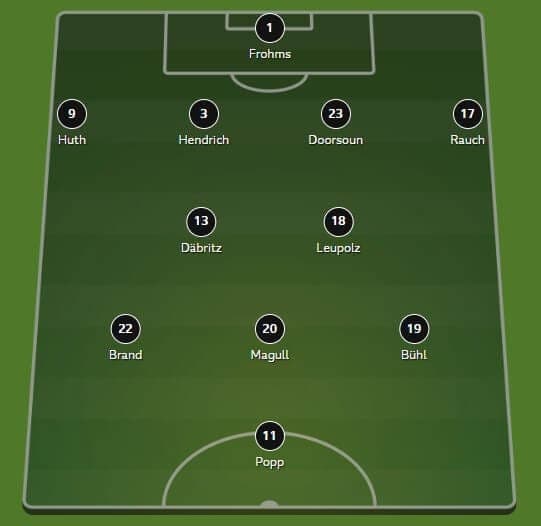
Germany had not escaped the pre-tournament injury crisis in the women’s game, with right-back Giulia Gwinn and Bayern Munich Frauen teammate Linda Dallmann, both of whom had starred in their run to last year’s final, being ruled out of appearing at the World Cup with long-term injuries.
They were also missing Wolfsburg Frauen midfielder Lena Oberdorf for this match and had doubts over Marina Hegering. So there was a need for some brave calls to be made and for some players to be put in unfamiliar roles to cover their absences. Influential forward Svenja Huth was one of those, with her dropping to right-back for this encounter, whilst a double pivot of Lyon Féminin’s Sara Däbritz and Chelsea Women’s Melanie Leupolz was included in place of Oberdorf.
The other big call that Voss-Tecklenburg needed to make was whether Alex Popp or Lea Schüller should lead the line, and, as many expected, it was the former that she plumped for.
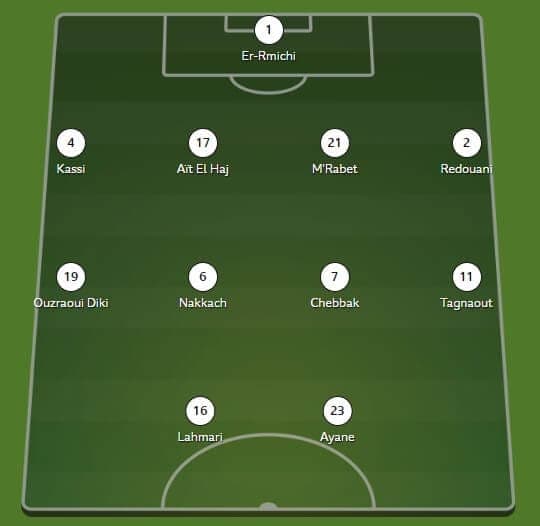
For Morocco’s first-ever World Cup appearance, head coach Reynald Pedros selected a 4-4-2 formation and opted not to play around with alternative combinations. Instead, many of his team were in their favoured roles, with some notable names being Tottenham Hotspur Women’s English-born forward Rosella Ayane and AS FAR Women star Ghizlane Chebbak. Meanwhile, full-backs Sarah Kassi and Zineb Redouani were tasked with keeping Germany’s influential wingers Klara Bühl and Jule Brand quiet.
Positional rotations
When looking at Germany’s overall game plan, several key points stood out, and one was the fluid formation that they adopted from the first whistle, with Voss-Tecklenburg giving her players the freedom to move around the field in a bid to increase their unpredictability when they had the ball.
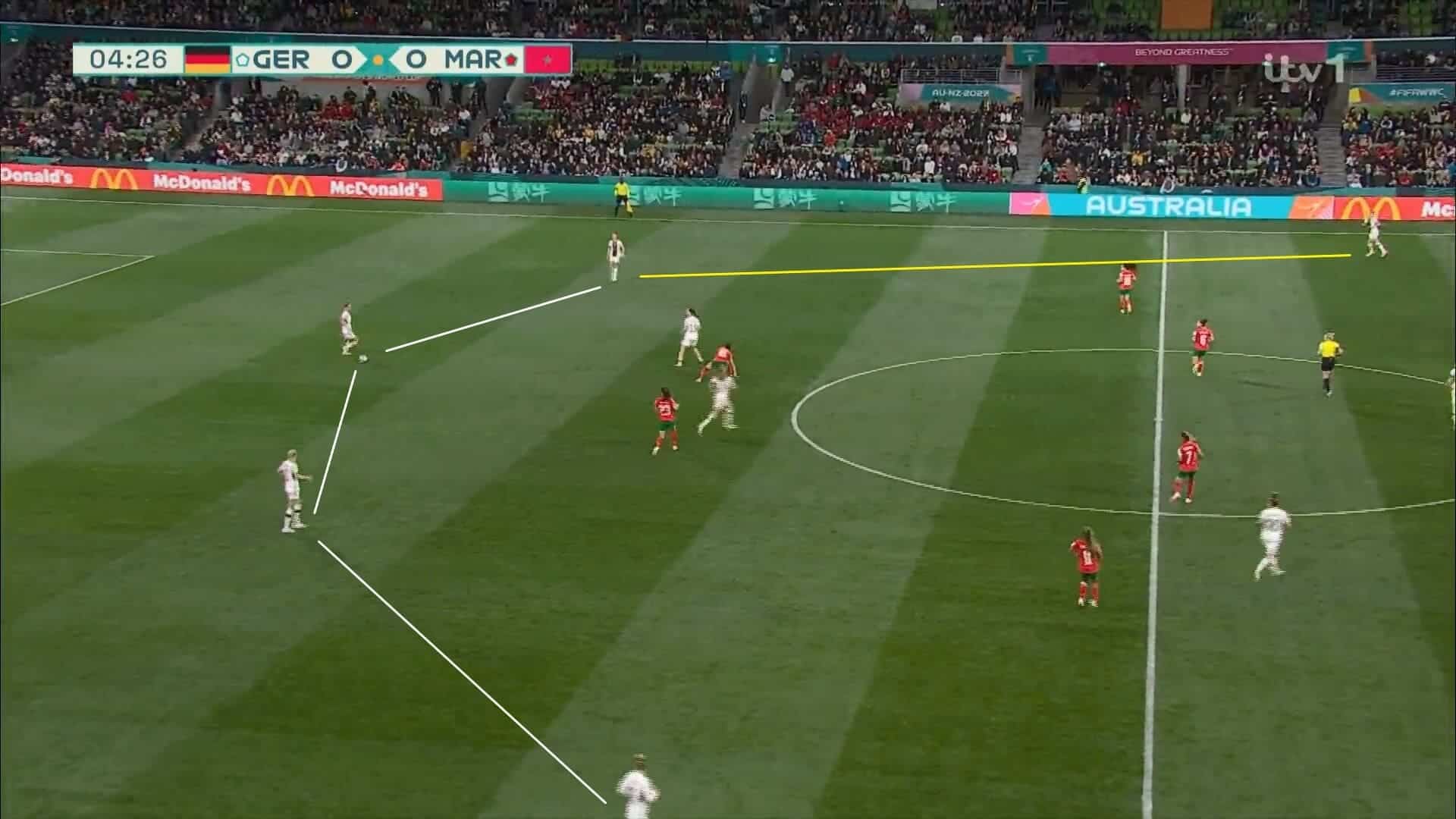
Those in the wide areas were required to be incredibly mobile, as Voss-Tecklenburg knew that Huth would not want to stay in a right-back role and instead look to push forward as often as possible to join their attacks. Kathrin Hendrich, as the right-sided centre-back, would therefore be constantly moving across to cover her, and she would then pull Sara Doorsoun and Felicitas Rauch with her to prevent gaps opening up that Morocco could exploit.
However, the left side would be left unoccupied if this occurred. So Voss-Tecklenburg needed to find a way of dropping someone back to protect that area and to remove the possibility of Germany being exploited through a Moroccan counterattack. The plan that she came up with was for Bühl to continuously move up and down the wing to offer support both in defence and attack, with Germany’s shape morphing into a back five much of the time as a result and allowing Huth and Bühl to alternate with each other and ensure that there was never any chance of those in the middle being completely isolated.
There was another benefit to having Rauch operate as a third centre-back because it gave Germany a one-player advantage against the Moroccan forward line, composed of Ayane and Anissa Lahmari, which was vital as both are quick players who made it clear on several occasions in the early stages of this match how dangerous they are if given chances to get behind opposing defensive lines.
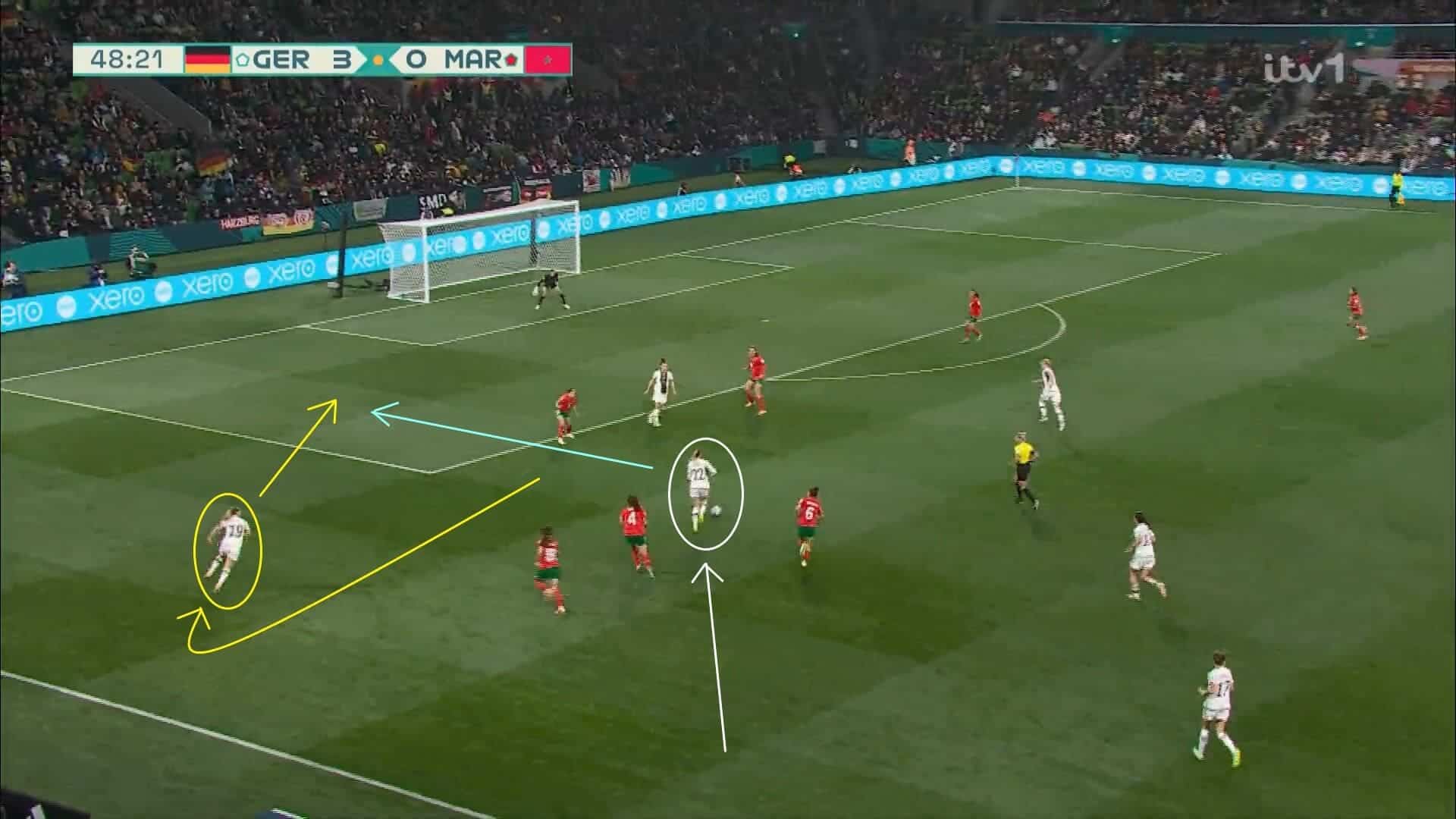
Positional rotations were also prominent in the forward line, with the midfielders and forwards continually switching channels and linking up with each other, and that often led to situations like this where Brand and Bühl ended up on the same side of the field.
Germany may be overbalanced at this point, and Morocco can now cut them off. However, this is what the former had planned for, as they wanted to manipulate the Moroccan defence into leaving spaces open and allowing them to access the spaces beyond. In this case, Brand is looking to do just that by running at the heart of the defensive line, whilst Bühl has shifted towards the sideline to ensure that the pitch stays as big as possible.
This is only temporary from the Bayern Munich player, though, as, at the right moment, she turns and starts to run back towards the goal area, with her path now clear due to the Moroccan defenders ignoring her and focusing purely on Brand.
The final detail is for Brand to release the ball and for Bühl to control it and shoot at goal, both of which happen here, and, but for an offside flag, this would have been a potential goalscoring opportunity. On this occasion, it wasn’t, but the fact that Bühl had already scored from a similar position with the first attack of the second half showed that it was an effective aspect of Germany’s offensive play and another reason they won the game, so comfortably in the end.
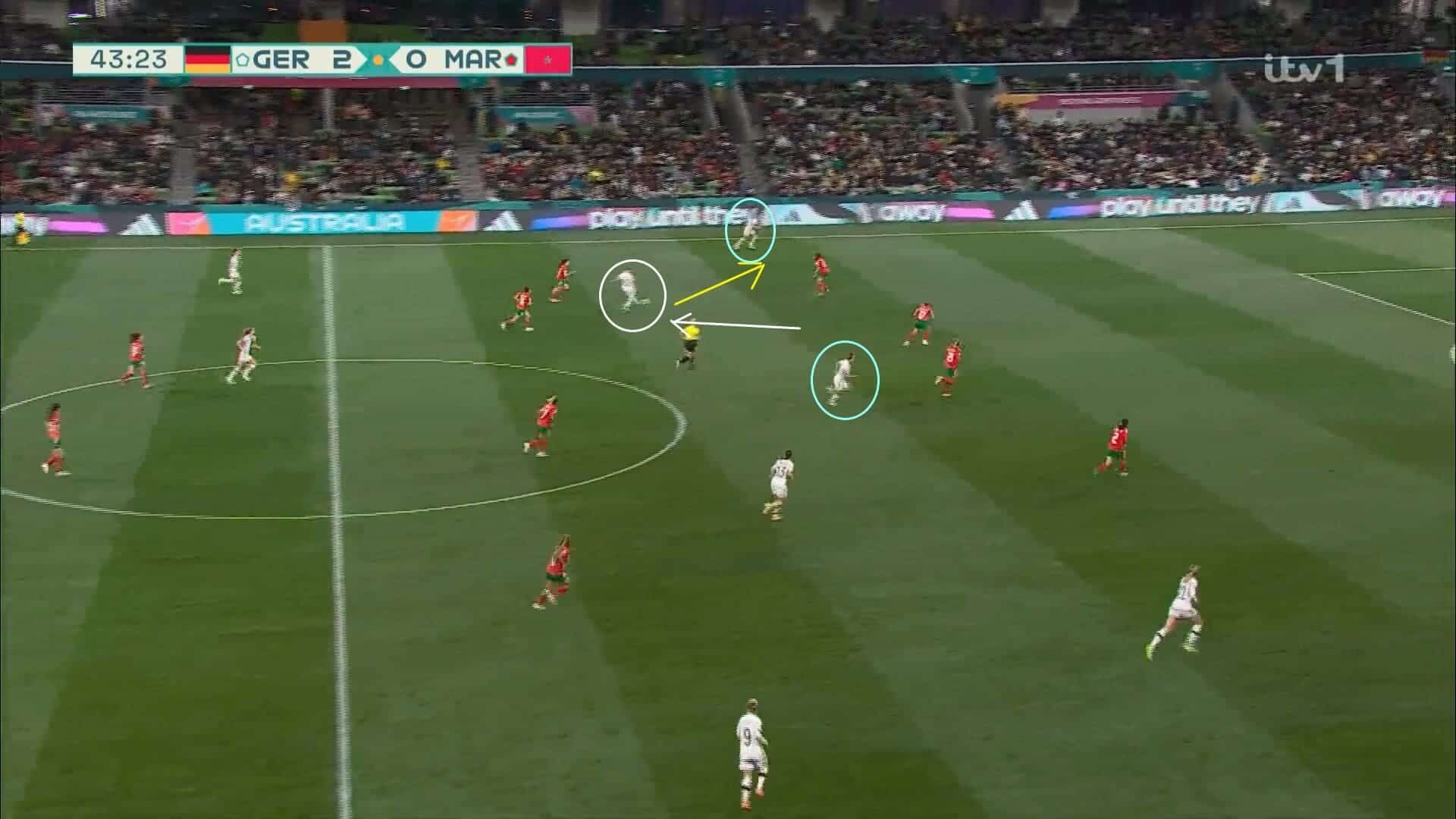
Morocco, for their part, did have an organised structure without the ball, and their players knew their roles and the importance of maintaining line discipline. However, their issue was that they left too much space between their ranks for Germany to exploit, which the latter constantly used to their advantage.
With them knowing that they could play into these gaps, Germany could simply position players between each Moroccan line and play simple passes during their transitions. However, what is interesting to look at here is who dropped back to offer Leupolz a passing option because it’s Popp who does so in this situation and Bühl and Lina Magull who run ahead of her.
The movement itself is not the critical point, but it is the fact that Germany’s captain was getting involved in building play as well as offering a presence at the top of the field, as it once again highlighted how positional rotations were at the heart of everything that they did well.
Playing without Lena Oberdorf
It was mentioned at the beginning of the analysis that Germany had been forced to go into the start of their World Cup campaign without Oberdorf, and, given her importance over the years for her nation, her presence was always going to be difficult to replace.
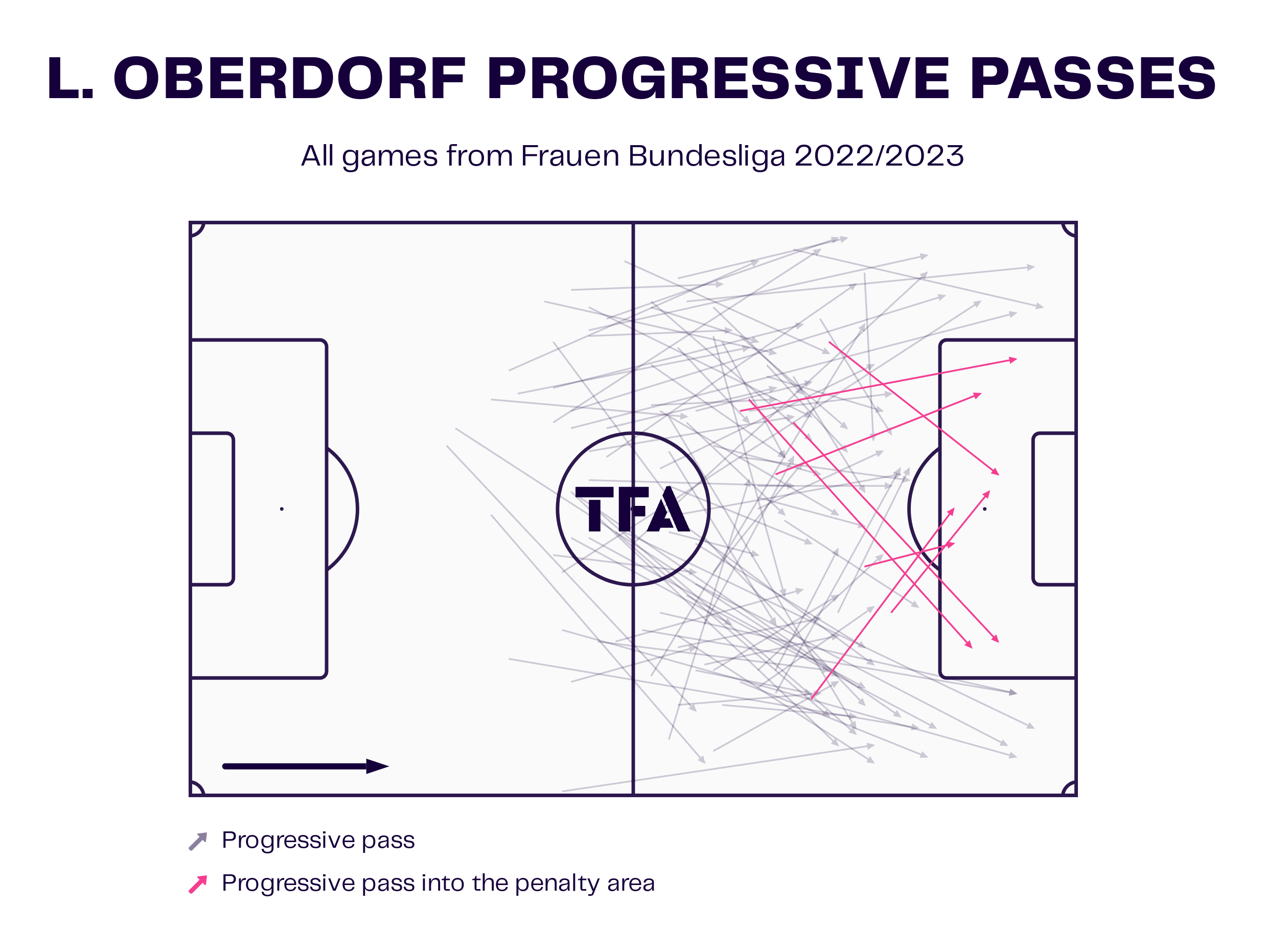
The key thing that she offers when her team has the ball is distribution, and this graphic indicates how she sends balls up the field for her teammates to get on the end of. The accuracy of her passing is one of the reasons that both Wolfsburg and Germany can keep their other midfielders high up the field, with her operating very capably on her own as an archetypal six who can sit back and create chances from inside her half.
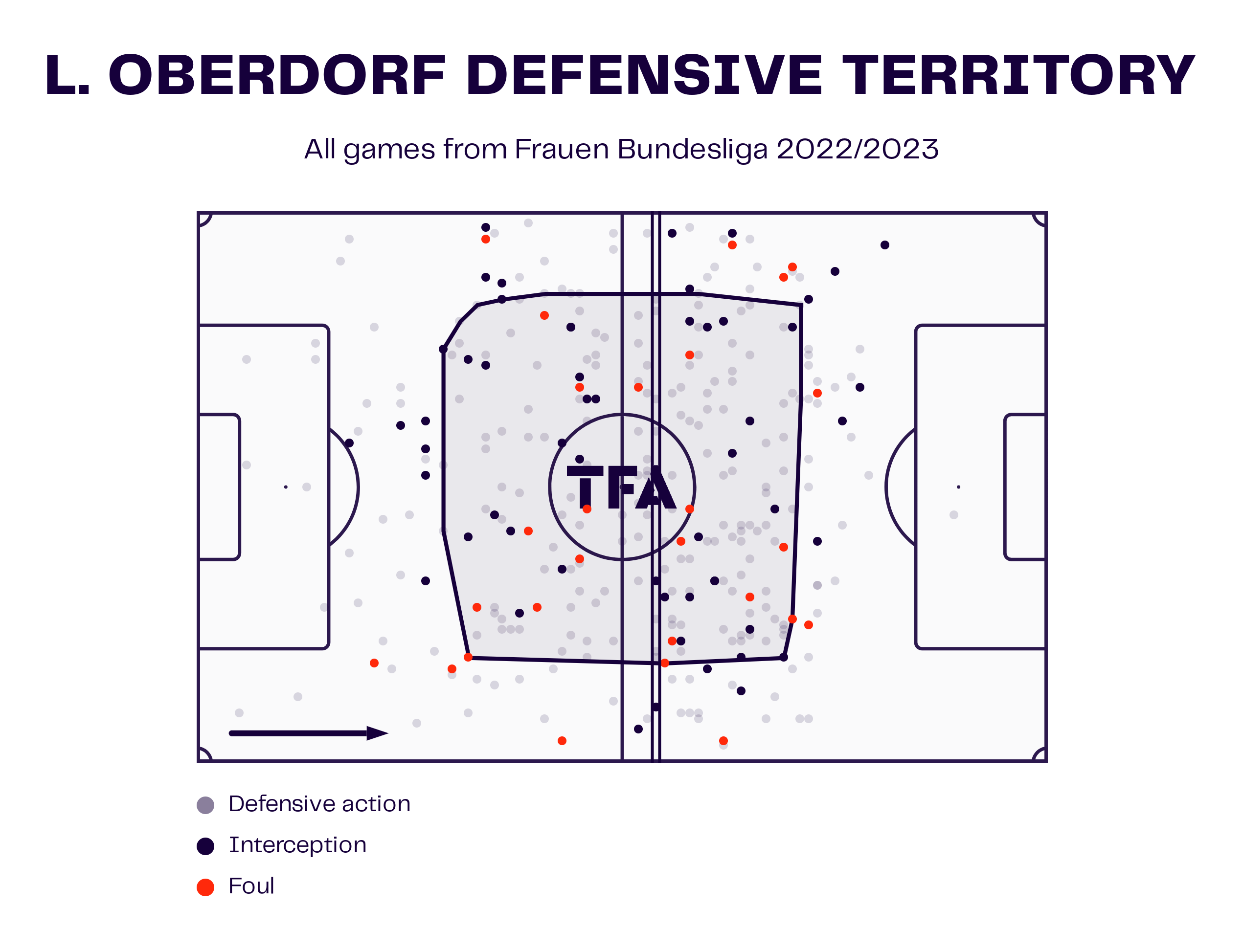
Once her team loses possession, her role immediately switches to disrupting opponents and preventing them from building any rhythm when they are in transition. She is the one who patrols the centre of the field and makes interceptions when chances to do so present themselves to her, as this graphic demonstrates.
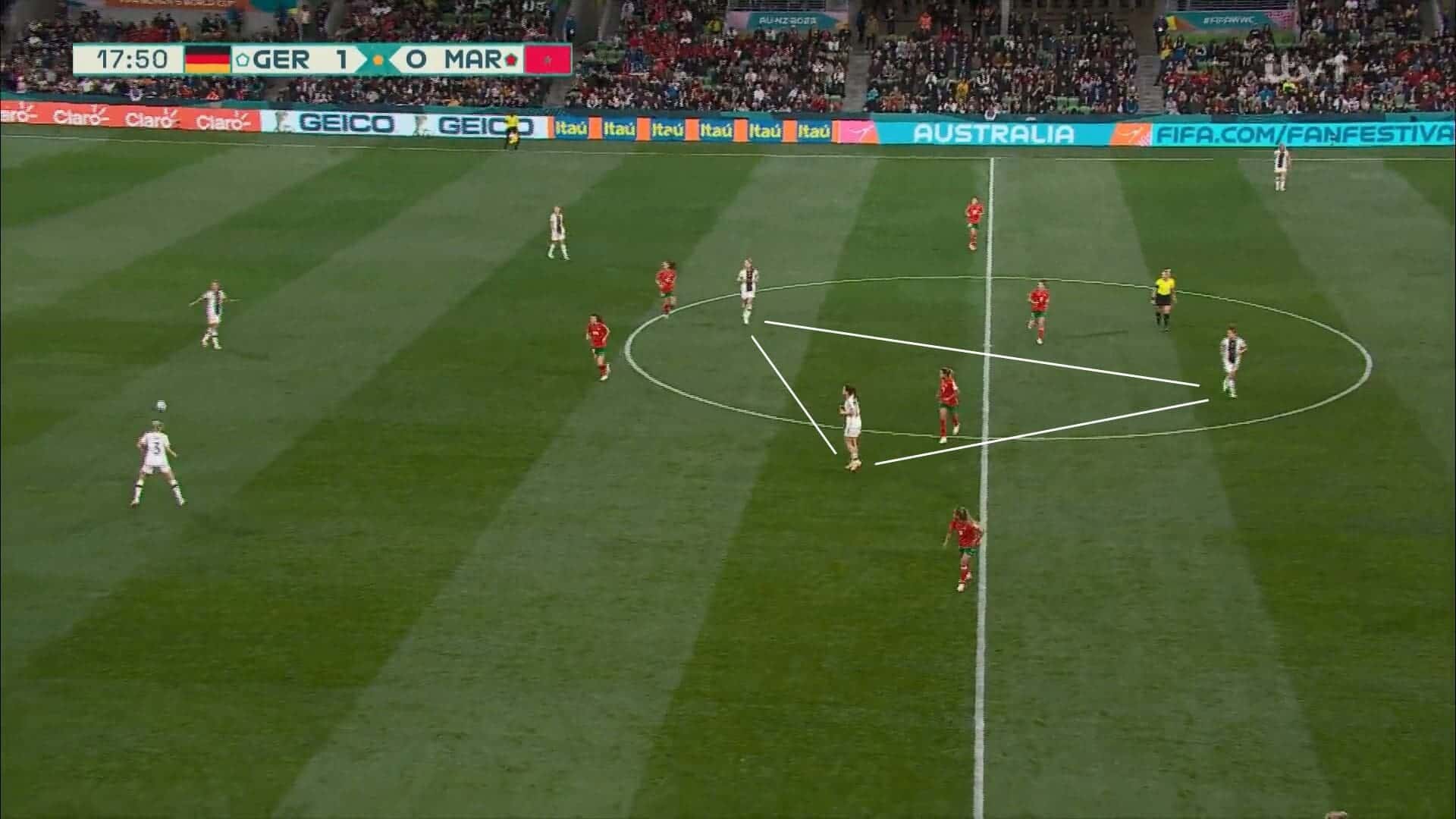
With all of this in mind, it can be seen just how difficult a task it would be for Voss-Tecklenburg to find a way of replacing what she brings, with not many in the squad offering everything she does.
However, the solution she came up with was to deploy Däbritz and Leupolz together, with Magull ahead of them. The reason that she opted for those two was that their games complement each other in that Leupolz is more of a deep-lying distributor who can break through lines with her passes, whilst Däbritz has tended to play as a box-to-box operator who connects different areas of the team together. As a result, they would take up slightly different positions, as they have here, and would not compete for the same areas of the pitch.
As is the running theme, though, rotations were ingrained in their central third play, with all three midfielders dropping back and running forward at times to set up attacks and keep the ball moving. So the triangle shown here continually altered as they worked hard in defensive and attacking situations.
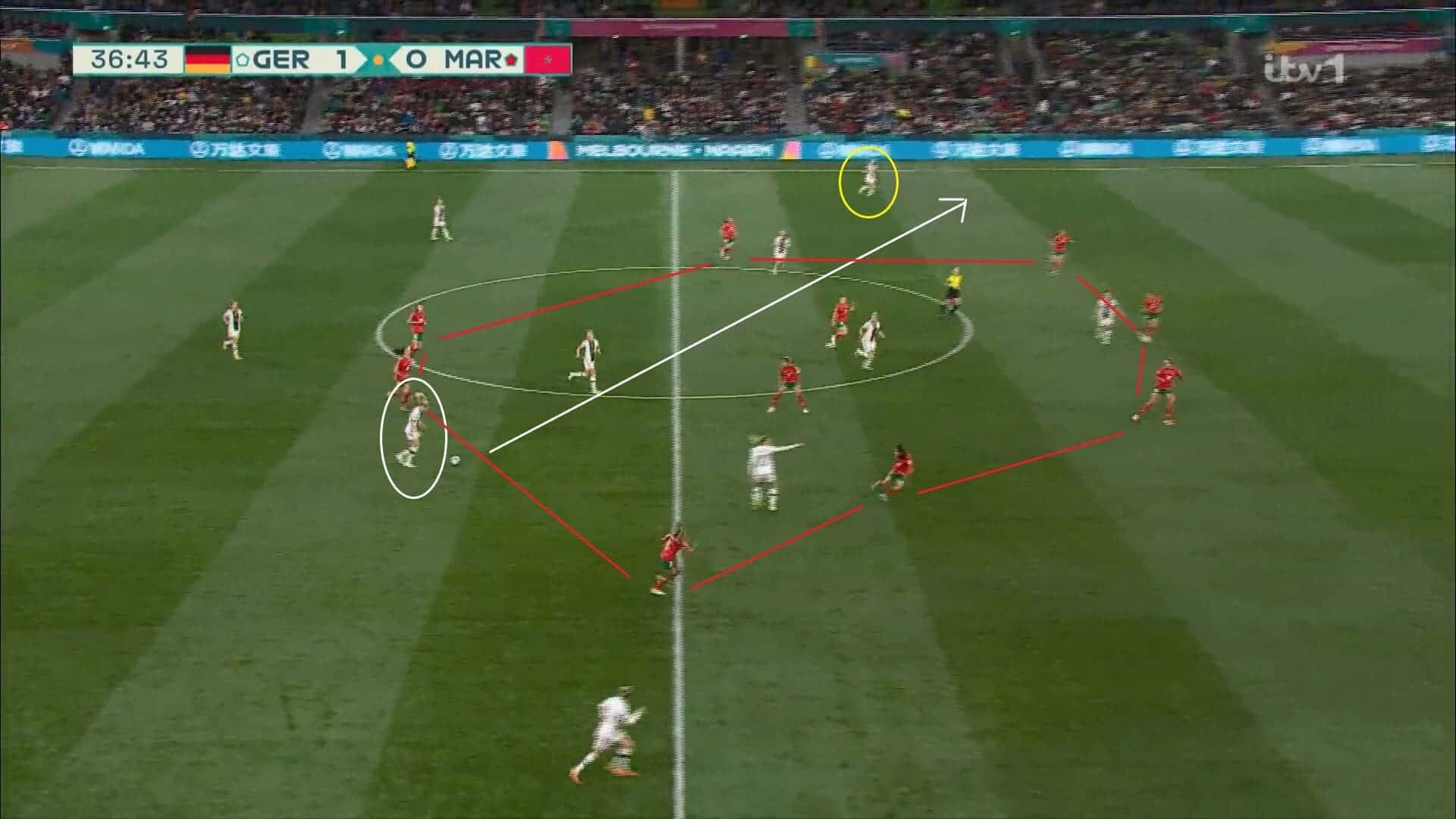
Germany didn’t only look to play through the thirds, though, and did sometimes resort to longer, more direct passes as they tried to catch Morocco inside their own third. This was made easier by Morocco’s setup, with Pedros’ players opting to stay compact and focus on protecting the central channel. However, Germany still needed to get the ball to the right people in order to switch play and find those in space on each side of the field.
This is where the centre-backs came in, and Hendrich in particular, with the experienced Wolfsburg player known for her abilities with the ball at her feet and ability to read the game. On this occasion, her pass didn’t have the necessary accuracy and was cut out by Kassi before it could reach Bühl, but there were plenty of times when Germany caught Morocco in these situations.
The fact that they could change between tactics and dictate play in the manner that they did without Oberdorf being there will have given them a lot of encouragement going into the rest of the tournament, and they now have a plan should the influential midfielder not be available for their next outing.
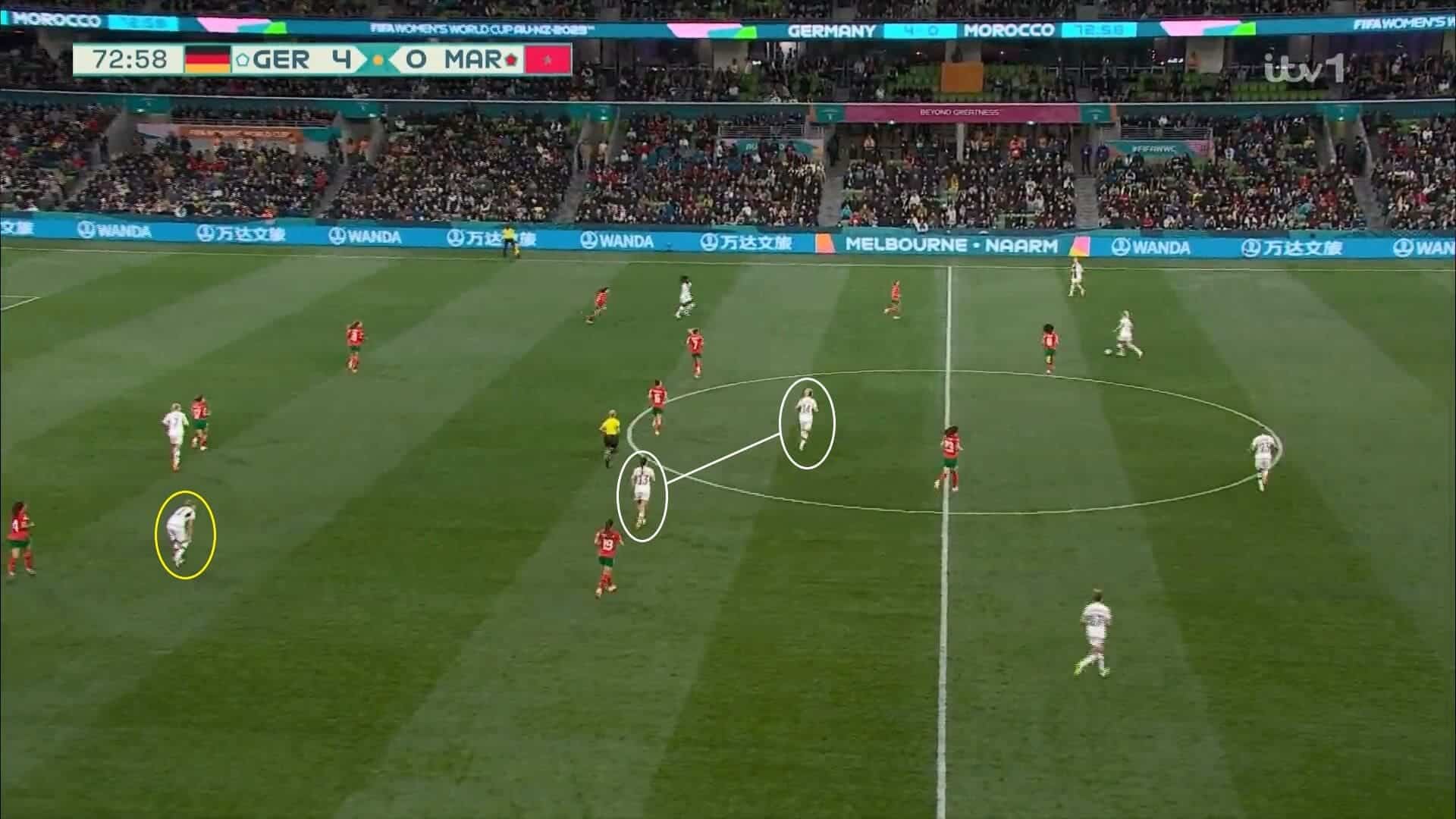
In the second half, Morocco did become a little more alert to this style of play and looked to press individual German players with an added intensity, meaning that those longer passes were not as easy to make, but that was not a problem and is where Germany’s squad depth comes in.
Voss-Tecklenburg realised relatively quickly that there was a need for her team to have a more structured setup in the midfield as the game went on. So she withdrew Bühl, Magull and Leupolz and sent on Lena Lattwein, Nicole Anyomi and Schüller in their places. Anyomi and Schüller moved into the forward line whilst Lattwein dropped into the central third, and, although she is more of an eight than a six, she can play in front of the defensive line if needed.
Therefore, with her in position, Däbritz retaining her role, and Popp dropping back to allow for Schüller to play in her usual centre-forward role, Germany had a new look but one that enabled them to maintain their passing lanes during transitions and to keep looking for ways to break Morocco down.
Pressing without the ball
The match wasn’t entirely in Germany’s favour, though, and they did need to work hard without the ball and with it. However, this is something that they have always been good at, and history has shown that they have a very effective way of regaining possession once it has been conceded.
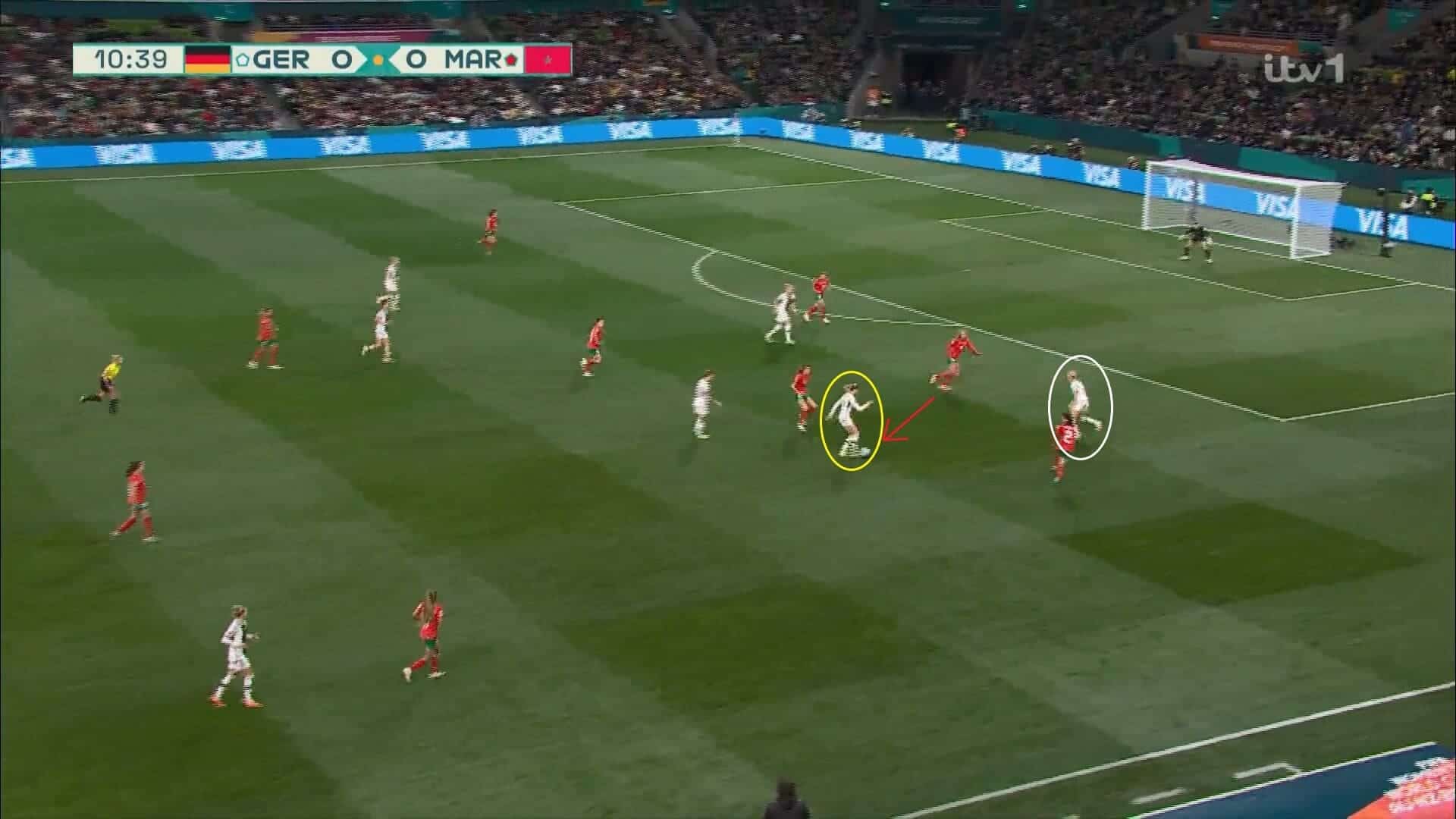
When looking back to their opening match of Euro 2022, against Denmark at Brentford’s Gtech Community Stadium, what stood out about Germany’s play was how they forced Denmark to give the ball up and to play into their hands. To explain, their key tactic revolved around allowing the Danish players to have the ball but playing with an aggressive press and removing time and options from them, with the aim being to force them into making rushed clearances that only went as far as the German midfielders, who formed the second line of their attack.
It was a game plan that proved to be hugely successful for them, and they took the basic principles of it into this game as they once again tried to push forward and take time away from the Moroccan backline. Their aforementioned rotations and fluid structure were again instrumental in making this happen, as it allowed the midfielders and, in this case, the defenders to join in, and that is shown here by Hendrich getting tight to Ayane before then switching targets to close down Yasmin Mrabet once the ball had moved towards her.
As a result, Mrabet had little time to make a decision and played a hurried pass away from Hendrich, but only found the waiting Brand behind her. At that point, Germany had the advantage, with Brand feeding the ball through to Hendrich, who then set up Popp to score the game’s opening goal.
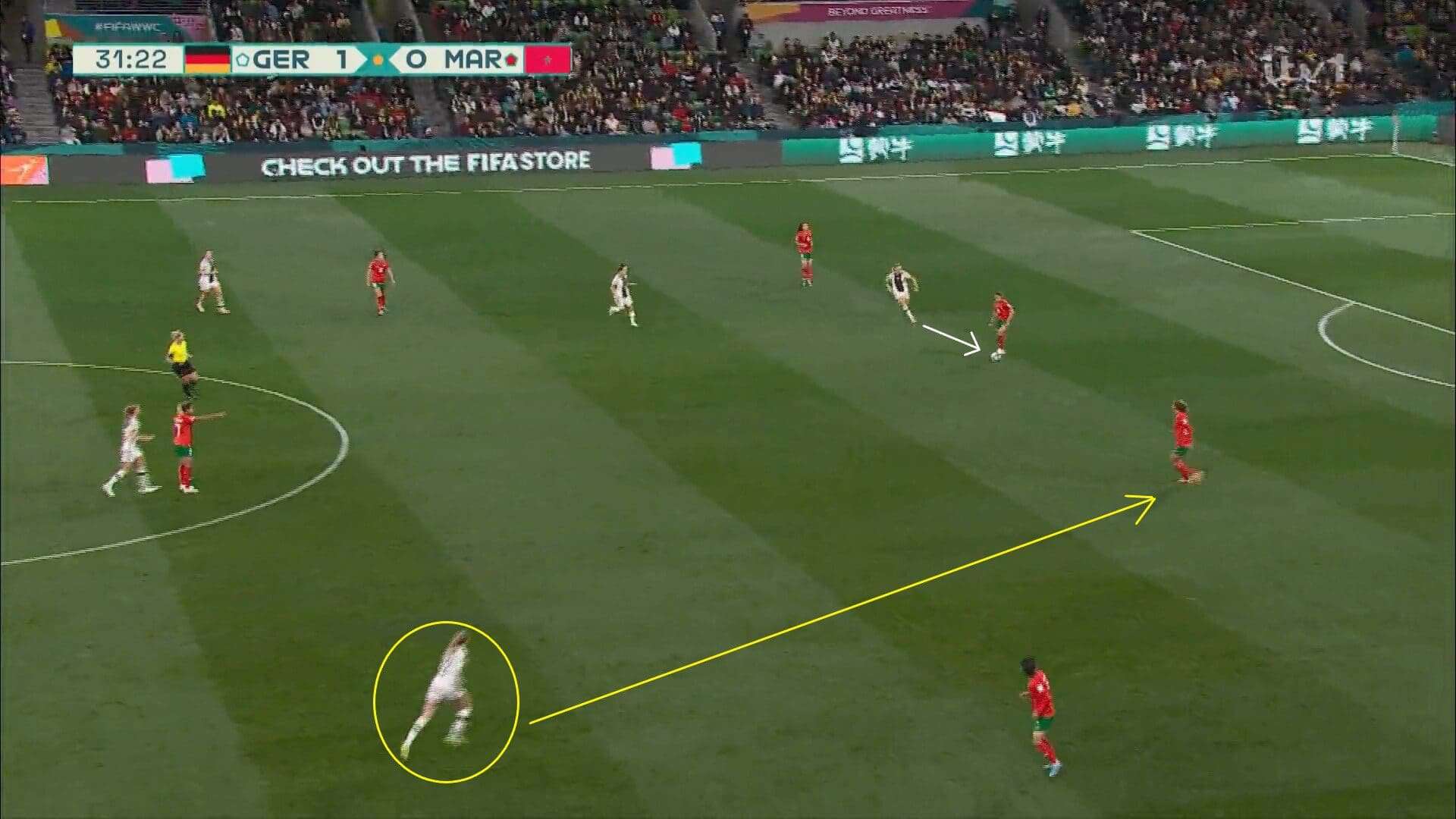
The key detail in this tactic was the ability of individual players to time their runs, and Brand proved to be especially good at this as the game went on. Here, the Wolfsburg winger has noticed that Bühl has cut inside to close Morocco down and so looks across to where the ball will travel next before moving forward to press that player and to ensure that they will have just as little time once it arrives at their feet.
The speed at which she presses is frightening, and it was one of the reasons that she was one of Germany’s best players in this game. She has sometimes needed to play in midfield in her still-developing career, so dropping back and moving forward was not a new experience for her. Still, there is little doubt that she executed this part of Germany’s game plan well and played a significant role in allowing her team to be so threatening without the ball.
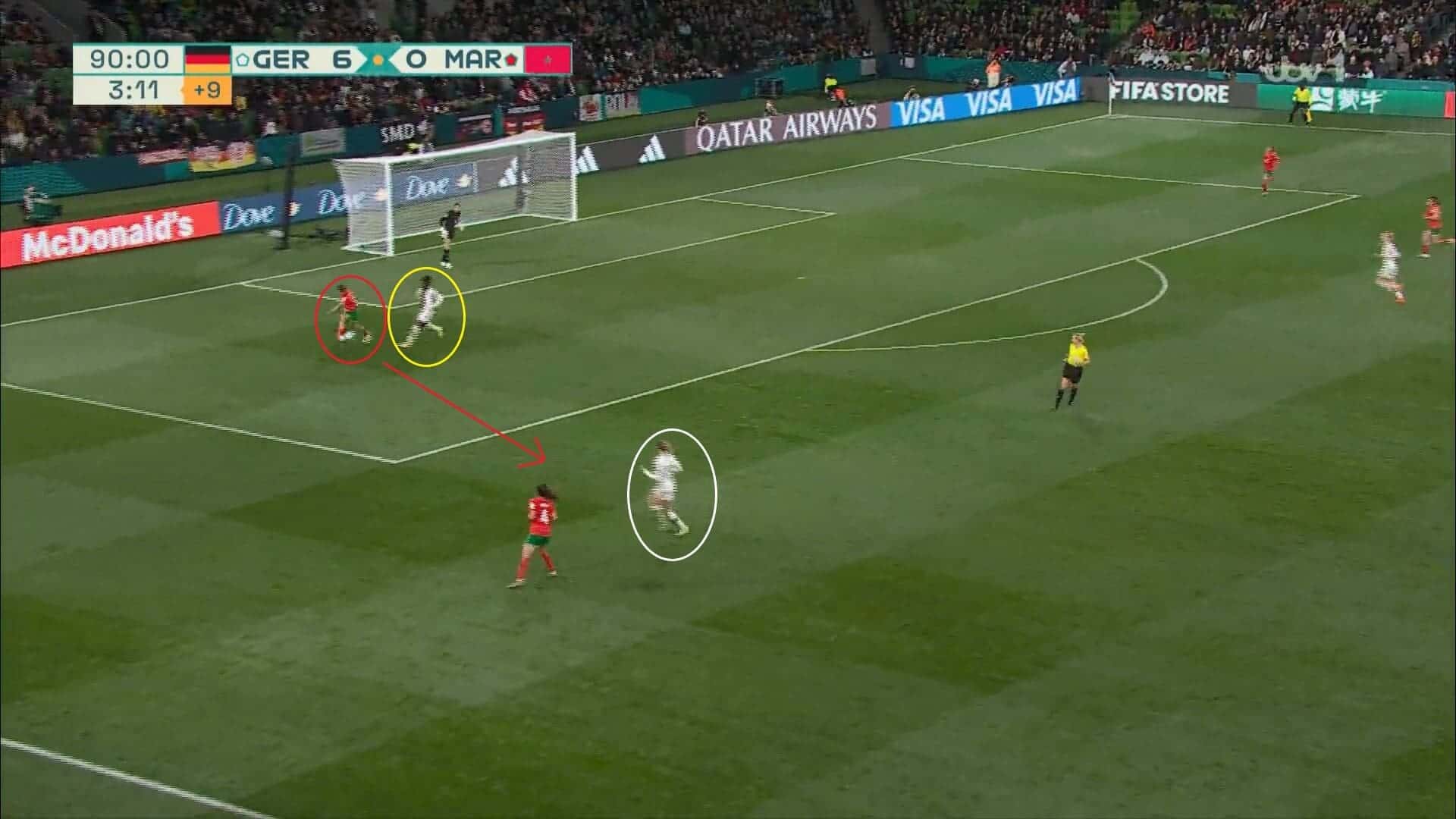
However, getting the timing right also means knowing when to move forward and when to delay the run, and that was something else that Brand got right on more occasions than not. In this case, Anyomi has closed down Hanane Aït El Haj, and Brand knows that the ball will travel towards Kassi, who is ahead of her, as Anyomi’s body position has ensured that no other option is available for the AS FAR defender here.
With that knowledge, she could have made an immediate run and closed Kassi down in the same manner as she did in the previous example, but she instead delayed for a second, and the reason that she did so is that the tight angle of the pass increases the chance of the ball ricocheting off Anyomi’s foot in transit.
Therefore, moving slightly later allows Brand to adapt her run if it did take a different trajectory, and the fact that she was able to make a sharp change in direction to head the ball back towards Anyomi before Kassi could react here was due to her again executing the timing of her run precisely.
Conclusion
In conclusion, this tactical analysis has looked in detail at the tactics that title hopefuls Germany deployed against Morocco, breaking down their style of play and analysing why they registered the biggest margin of victory at the World Cup at the time of writing.
What became apparent at the end of the match was that Voss-Tecklenburg’s side had a very clear idea of their identity and how they wanted to approach games. The teamwork that was on show in this game demonstrated a solid understanding of where the spaces were around the field and who needed to move where to keep their shape, and that comes down to hard work on the training ground as they look to ensure that they start the game in as positive a way as they can.
Suppose they continue in this frame of mind. In that case, Colombia, South Korea and any other side that faces them will have a challenging task keeping them quiet, and it really is an ominous reminder of just why Germany are one of the red-hot favourites to lift the trophy.





Comments